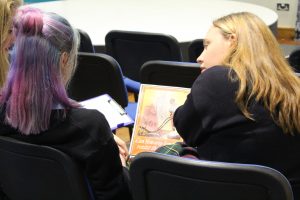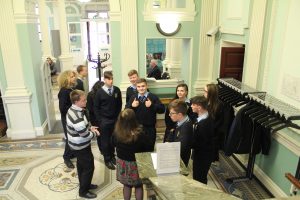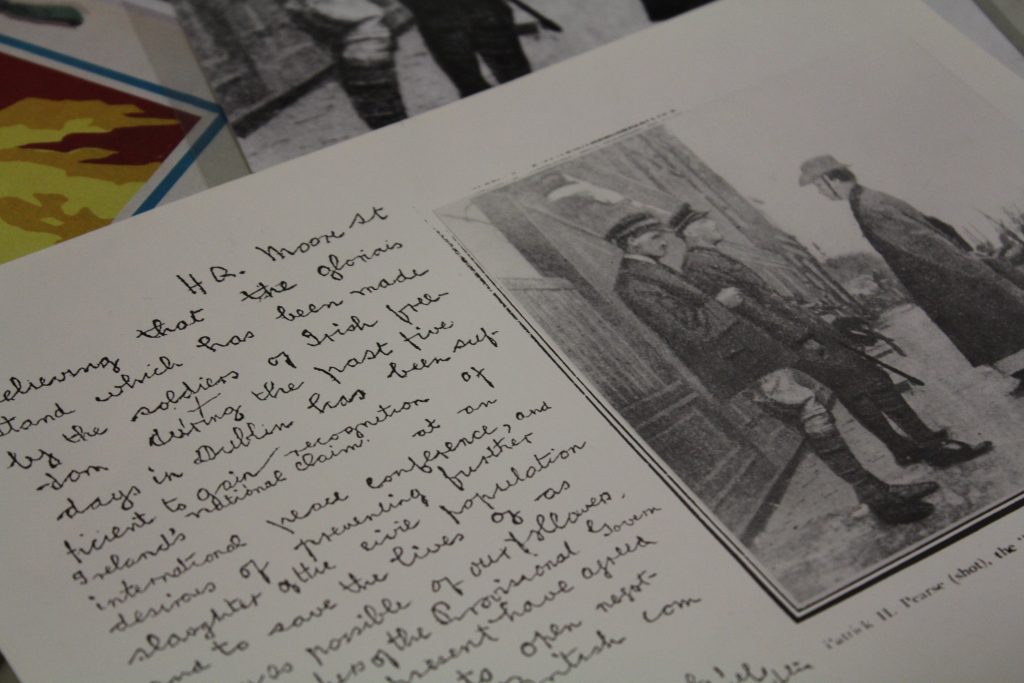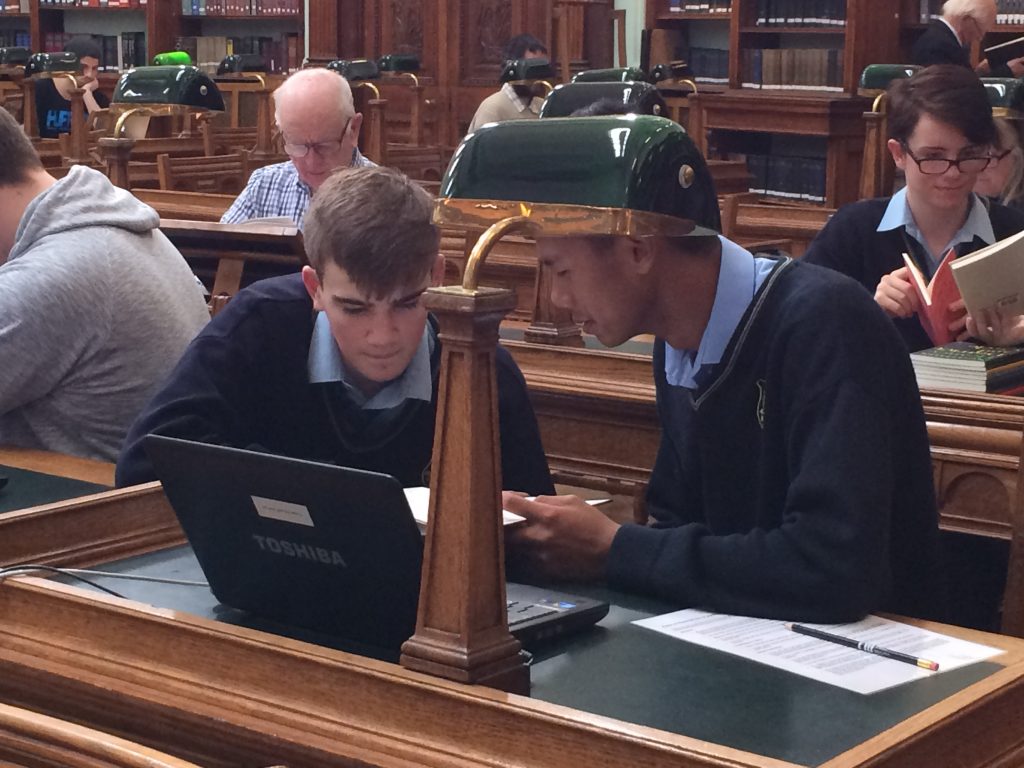In Autumn 2016 Letters of 1916 partnered with the National Library of Ireland, An Foras Feasa, DiXit, and Maynooth Post Primary to host a three-day workshop, with to introduce transition year students to new forms of digital scholarship, scholarly editing, and to explore the 1916 Easter Rising from a novel perspective.
 On the first day of the workshop the students were introduced to the Letters of 1916 project and learned how to upload a letter to the site. After a brief presentation, students learned about the digital collection through a digital ‘treasure hunt’ covering a range of historical topics, from the Easter Rising 1916 to Irish suffragettes. Once familiar with the site, the students were introduced to metadata and with key features of digital preservation of analogue materials. The students then began the process of uploading letters into the Letters of 1916 database. The letters were taken from two of the National Library’s collections, that of Francis Sheehy Skeffington and Art O’Briain; both prominent figures in 1916. The correspondence covered topics such as war taxation, suffragism, and internment. The students readily engaged with the sources, prompting some to carry out independent research into authors, recipients and topical issues in 1916. The following comment is representative of their experience:
On the first day of the workshop the students were introduced to the Letters of 1916 project and learned how to upload a letter to the site. After a brief presentation, students learned about the digital collection through a digital ‘treasure hunt’ covering a range of historical topics, from the Easter Rising 1916 to Irish suffragettes. Once familiar with the site, the students were introduced to metadata and with key features of digital preservation of analogue materials. The students then began the process of uploading letters into the Letters of 1916 database. The letters were taken from two of the National Library’s collections, that of Francis Sheehy Skeffington and Art O’Briain; both prominent figures in 1916. The correspondence covered topics such as war taxation, suffragism, and internment. The students readily engaged with the sources, prompting some to carry out independent research into authors, recipients and topical issues in 1916. The following comment is representative of their experience:
We went to the University of Maynooth and visited An Foras Feasa. There we learned about basic metadata and also how to upload and transcribe a letter. It was very interesting, as we learned and read about people and their situations in that period of history.
 On the second day of the workshop the students were introduced to the transcription phase of the project. Using the letters they had uploaded the previous week, students were introduced to XML encoding.. While the process was challenging, the students were soon able to engage with the task and worked together to determine the best way to implement their new knowledge. . Aside from learning new computational skills, the detailed reading required for this process provided a unique opportunity for the students to engage deeply with primary sources. . When the second day came to a close students were confidently talking talk about new and interesting details they had uncovered about Irish life in 1916. As one student put it;
On the second day of the workshop the students were introduced to the transcription phase of the project. Using the letters they had uploaded the previous week, students were introduced to XML encoding.. While the process was challenging, the students were soon able to engage with the task and worked together to determine the best way to implement their new knowledge. . Aside from learning new computational skills, the detailed reading required for this process provided a unique opportunity for the students to engage deeply with primary sources. . When the second day came to a close students were confidently talking talk about new and interesting details they had uncovered about Irish life in 1916. As one student put it;
I learned about how the people lived during the Rising. Something that you don’t get in history books. Transcribing was also very fun but some of the letters were hard to read. Learning about the coding was cool.
The transcription process provided interesting challenges: some letters needed to be decoded almost word-by-word due to the nature of the challenging handwriting, others proved difficult because unusual syntax and vocabulary of a century ago. One of the most enjoyable finds for some of the students was a handwritten postcard in Irish, while the old Irish proved to be extremely difficult , the students enjoyed challenging each other to work it out.
 The third day of the workshop was spent in the National Library of Ireland. Bríd O’Sullivan and Emma Edwards from the NLI welcomed the students and gave a tour of the library’s exhibitions, reading room and demonstrated the wealth of historical and cultural materials held at the library. The students then worked together to analyse ephemera from the 1916 period, such as recruitment posters from the Great War and political cartoons from the era. This response was typical of the student experience of the NLI:
The third day of the workshop was spent in the National Library of Ireland. Bríd O’Sullivan and Emma Edwards from the NLI welcomed the students and gave a tour of the library’s exhibitions, reading room and demonstrated the wealth of historical and cultural materials held at the library. The students then worked together to analyse ephemera from the 1916 period, such as recruitment posters from the Great War and political cartoons from the era. This response was typical of the student experience of the NLI:
I enjoyed our trip to the NLI on Monday. I learned a lot about what they do there and their projects such as Letters of 1916… Overall I enjoyed it and recommend doing this with all TY classes.
 The Letters of 1916 thanks Bríd, Emma and all the staff at the NLI for their help in running this event, as well as Peter and the students of Maynooth Post Primary for the opportunity of working with them on this exciting project. We also thank DiXIT, the advance training network in digital scholarly editing for funding this workshop.
The Letters of 1916 thanks Bríd, Emma and all the staff at the NLI for their help in running this event, as well as Peter and the students of Maynooth Post Primary for the opportunity of working with them on this exciting project. We also thank DiXIT, the advance training network in digital scholarly editing for funding this workshop.
If you’re interested in finding out more about how the Letters of 1916 can be used in the transition year classroom, visit 1916 in Transition for lesson plans, teaching materials and more. As ever, feel free to contact the Letters of 1916 team with any questions or queries at letters1916@gmail.com or on twitter at @letters1916


